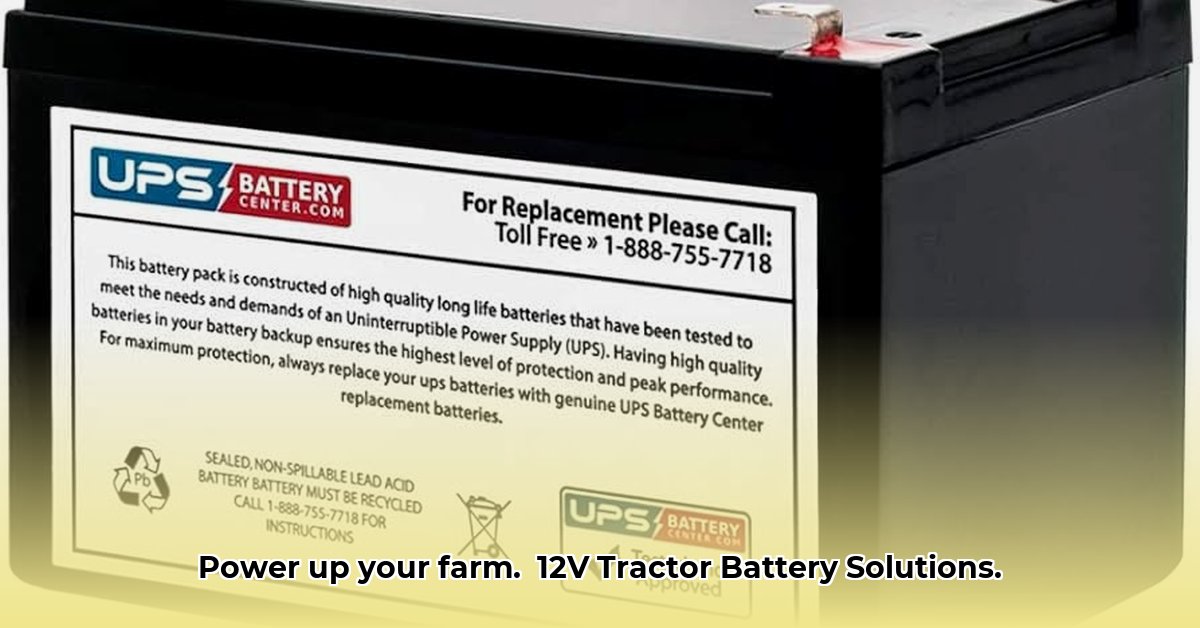
Understanding Your Tractor's Energy Demands and Choosing the Right Battery
Your tractor's 12-volt battery is its lifeline, powering essential systems and ensuring reliable operation. A poorly maintained or improperly selected battery can lead to frustrating breakdowns, costly repairs, and reduced farm efficiency. This comprehensive guide will equip you with the knowledge to select, install, maintain, and troubleshoot your tractor's battery system. For more information on Ford 3000 tractor batteries, check out this helpful resource: Ford 3000 Battery Guide.
Before selecting a replacement, consult your tractor's owner's manual. This vital document specifies the recommended battery type, group size (physical dimensions), and cold cranking amps (CCA – a measure of the battery's ability to start the engine in cold temperatures). Ignoring these specifications can lead to improper fit and suboptimal performance. Isn't reliable cold-weather starting essential for a productive farming operation?
Choosing the right battery involves several key considerations:
Cold Cranking Amps (CCA): Higher CCA values ensure reliable starts even in freezing temperatures. Select a battery with a CCA rating exceeding your tractor’s requirements for added reliability. How much extra CCA is enough? Consult your tractor's manual for recommendations.
Reserve Capacity (RC): This indicates how long the battery can power accessories (lights, radio) with the engine off. Higher RC is beneficial if you frequently use these features. Is a higher RC worth the extra investment? Consider your typical usage patterns.
Group Size: This refers to the battery's physical dimensions. Ensure the new battery fits perfectly in your tractor's battery tray; forcing a battery into an unsuitable space can cause damage.
Battery Technology: Most tractors use flooded lead-acid batteries, but some may utilize maintenance-free or AGM (Absorbent Glass Mat) batteries. Always refer to your owner's manual for the correct type. AGM batteries, for instance, offer superior vibration resistance, making them ideal for farm equipment.
Here's a summary of key battery specifications:
| Specification | Description | Typical Values (Examples) | Considerations |
|---|---|---|---|
| Group Size | Physical dimensions of the battery | Group 31, Group 65 | Must precisely match your tractor's battery tray dimensions. |
| CCA | Cold Cranking Amps (power output in cold temperatures) | 600 CCA, 800 CCA | Higher is generally better, especially in colder climates. |
| RC | Reserve Capacity (minutes of accessory power with engine off) | 120 minutes, 180 minutes | Higher RC extends accessory usage without running the engine. |
| Battery Type | Flooded Lead-Acid, Maintenance-Free, AGM (Absorbent Glass Mat) | Varies | Check your owner's manual; incorrect type can cause problems. |
Installing Your New 12-Volt Battery: A Step-by-Step Guide
Replacing a tractor battery is straightforward, but safety is crucial. Follow these steps meticulously:
Safety First: Disconnect the negative (-) battery cable first, then the positive (+). Wear safety glasses and gloves.
Remove the Old Battery: Carefully lift out the old battery. It can be heavy.
Clean the Terminals: Use a wire brush to remove corrosion from battery terminals for optimal electrical contact.
Install the New Battery: Securely place the new battery in the tray; ensure a snug fit.
Connect the Cables: Attach the positive (+) cable first, then the negative (-). Tighten clamps securely.
Verify Connections: Double-check all connections are tight and secure to prevent issues.
Maintaining Your 12-Volt Tractor Battery: Extending its Lifespan
Regular maintenance significantly prolongs battery life and prevents costly breakdowns.
Fluid Level Checks (if applicable): For flooded lead-acid batteries, periodically check the electrolyte fluid level. Add only distilled water if needed.
Terminal Cleaning: Regularly clean corroded battery terminals to maintain conductivity.
Voltage Testing: Periodically check battery voltage using a multimeter; low voltage may indicate problems.
Troubleshooting Common 12-Volt Battery Problems
Addressing problems quickly prevents larger issues.
Slow Cranking: This could indicate low CCA, a worn starter motor, or corroded/loose cables.
Dead Battery: Investigate for parasitic drain, sulfation, or battery age.
Damaged Cables: Inspect cables for corrosion, fraying, or loose connections.
Proactive battery maintenance is key to preventing expensive repairs and maximizing your farming productivity. A healthy battery is a fundamental component of a smooth and efficient operation.